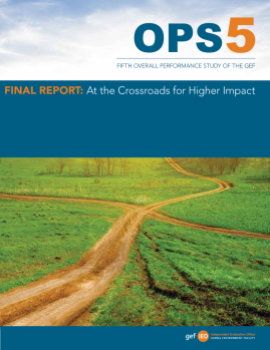This report has regrouped the key issues identified in the Fifth Overall Performance Study (OPS5) terms of reference into a new structure. After briefly identifying the international conditions in which the Global Environment Facility (GEF) must function, the business model is explored to identify where in the various processes of the GEF problems are emerging that need to be solved. These solutions will need to strengthen the intervention model of the GEF; this is the second part of the report. As a link between these two perspectives, the partnership and network nature of the GEF is discussed. As usual in GEF evaluation reports, the findings of both are integrated into overall, comprehensive conclusions and recommendations; these are presented in chapter 2. The subsequent chapters provide the evaluative evidence for these conclusions and recommendations. More detailed evidence can be found in the OPS5 technical documents, annex D.
OPS5 thus has three levels of information depending on how far the reader wants to go. For higher level conclusions, read chapter 2; the information here is sufficient and self-contained to support these higher level recommendations. For a deeper understanding of the issues raised in chapter 2, continue reading the report. For full disclosure of the data, approaches, and analysis, and more detailed suggestions on issues that could be tackled, read the respective technical documents.
The OPS5 terms of reference ask for an assessment of "the extent to which the GEF is achieving its objectives and to identify potential improvements." The key questions of OPS5 were divided out between the First Report (GEF IEO 2013e), presented at the first replenishment meeting, and this Final Report. The First Report provided a comprehensive overview of evaluative findings in the years since OPS4. It dealt specifically with the guidance from the conventions, and with a first assessment of the GEF portfolio on performance and impact. Its main findings were that GEF-5 had seen an interesting increase in multifocal area projects, and that progress toward impact was supported through several distinct mechanisms that ensured broader adoption of the solutions and approaches to globally relevant environmental problems that the GEF and its partners had supported countries in exploring.
The key questions for the Final Report include several issues that were assessed through sub-studies of OPS5, including, e.g., the role of the Scientific and Technical Advisory Panel (STAP), as well as cross-cutting issues such as gender. These substudies have separate technical documents; their findings have been presented in this report where they fit into the overall assessment of the GEF business model and intervention model. Annex B provides a road map of key questions and where their evaluative evidence can be found in this report.
